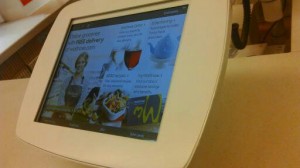Top 5 technologies to explore today
 As retailers and hospitality owners vie to attract and keep a customer’s trade a number of innovative technologies are getting in the mix. The challenge they face is which technology is worth investing in?
As retailers and hospitality owners vie to attract and keep a customer’s trade a number of innovative technologies are getting in the mix. The challenge they face is which technology is worth investing in?
The features and benefits of each tool brings with it new opportunity to both business and consumer, but those surrounding improved convenience and service levels are winning the race. There are five technologies in particular that any business, be it a store, hotel or restaurant, would be wise to consider the potential of. These are mobile, interactive, beacon, virtual and drone; and here’s a little about what they can do for you:
- Mobile – Many businesses today are taking advantage of technologies that work with a mobile device, because of its nature to directly interact with the customer. With 40% of UK consumers using a smart phone or tablet device to shop, the most prolific is unsurprisingly payment technology on a smart phone that is providing hassle free ways to make transactions. Zapp, a mobile payment expert, believes that letting a consumer skip to the good bit of a transaction as quickly and securely as possible, using just their mobile phone, is a key way to improve the customer experience. “Over the next five years, making it easy for shoppers to pay with a smartphone will become far more important than getting them to open their wallets”, says Zapp.
- Interactive – Touch screens are being used as interactive digital tools in the form of signage, tables and mirrors to help boost the customer experience. Such tools can offer a number of services such as providing access to location maps, product information and amusements, to calling for assistance, ordering items and designing your own product. Matthew Prebble, Accenture, says: “We have seen some UK retailers experimenting with in store technology to improve the holistic customer experience. That has ranged from tablet-equipped staff, and browse and order kiosks, to virtual rails, providing consumers with more access across all products, whether or not they are in stock”.
- Beacon – You can talk to your customers by sending communications to their smarts phones by using beacons that operate using low energy bluetooth. Although useful for providing generic information, beacon technology is more advantageous for targeted messaging, whereby depending on a customer’s proximity to a beacon, they are able to receive specific product information. Dave Shepperd, Experian Footfall, says: “Beacon technology is a smart and efficient way to communicate with smart phones and therefore with the customer within a certain proximity. Cheap, long lasting and relevant, it delivers the right message to the right people, at the right time…This type of technology could also provide deep insight into the consumer’s likes, dislikes and behavioural patterns, allowing brands to personalise promotions at a greater level.”
- Virtual – Most things these days can be done virtually and businesses are keen to maximise their selling potential by providing virtual life style experiences. A couple of examples of this Google Street View technology that lets a customer browse your store, hotel, restaurant or the like, and check out what you have to offer. Also, virtual reality headsets are enabling businesses to tale their customers beyond the physical to experience products or service in action – like a virtual fashion show for example. Anita Balchandi, OC&C Strategy Consultants, believes that Google Street View shows a lot of promise in areas of click and collect, price comparison and venue planning. She says: “This new venture from outside to inside acts to both improve a retailer’s online presence and highlights the unique visual and interactive aspects of the traditional in store retail experiences”.
- Drones – A bit futuristic and therefore not necessarily one for right now, but worth keeping an eye on are delivery drones. This technology has the capability to deliver products, via un-manned helicopters or the like, in minutes rather than hours or days even. It’s flexible enough to work behind the scenes for retail or hospitality businesses that need more stock, and also as a customer-facing tool for personalised delivery of their click and collect orders. Dave Shepperd, Experian Footfall, says: “Look at any sci-fi film and you will see streams of lanes of flying craft travelling on both parallel and perpendicular flight paths high above dystopian cities. Could this be the future of parcel delivery fulfilment?”
Source: Retail Week Innovation review 2014


No comments yet.